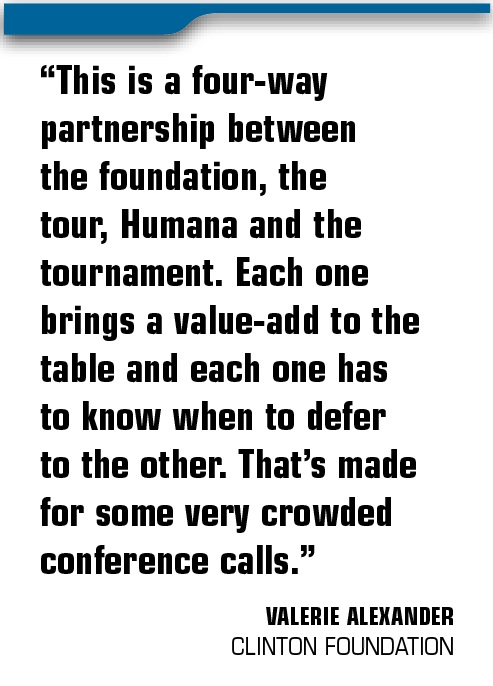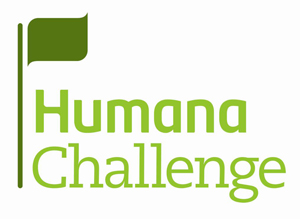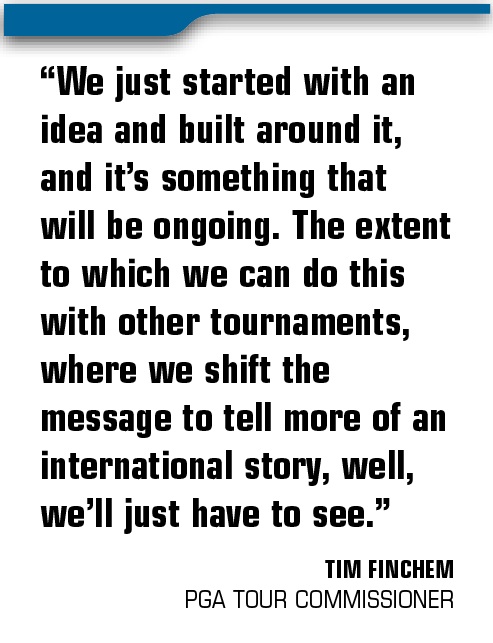More than a decade removed from office, Bill Clinton still commands a room. At 6-foot-2, with a lean build and distinguished head of thick gray hair, he stays in charge and is constantly on the move, circling the globe to make speeches and further his philanthropic efforts.
That’s why the PGA Tour executives knew they needed to nail their presentation to the former president when they entered the Clinton Foundation headquarters in Harlem, N.Y., on Nov. 19, 2010. Tour Commissioner Tim Finchem, himself molded in the political world, had talked to Clinton for years about getting involved with a tournament, but those talks only scratched the surface.
|
| Abe Madkour and Michael Smith on how partnership with the Clinton Foundation may have saved a tournament. |
This time, the tour had a more developed proposal that hit on key pressure points, including a prominent role for the foundation, which has become known around the world for working with the likes of Bono, Nelson Mandela and others to tackle issues such as childhood obesity and HIV/AIDS. In Finchem’s proposal, the Bob Hope Classic, an unsponsored event on the verge of collapse, would become a platform for the Clinton Foundation.
There were more loose ends than specifics at that point, but Clinton didn’t seem bothered. After meeting for more than an hour, he wrapped up by saying, “Let’s move forward.” And that was enough.
“President Clinton is a master of managing what his persona can do,” Finchem said. “When he wants to, he can move a lot of cheese around.”
At that point, the tour knew it had probably rescued one of its legacy tournaments, and at the same time, created a unique model that could transform what it means to sponsor an event. In what promises to be one of the most-watched sports affiliations of the year, the Humana Challenge aligns a cause — health and well-being — to the business of the title sponsor.
The tournament won’t be about advertising, branding and hospitality — the traditional reasons for sponsoring a tour event — as much as the health and well-being theme for the week, which will be addressed at a Clinton Foundation conference on the Tuesday before the Jan. 19-22 tournament.
It’s that cause that lured Humana on board as the title sponsor for an event that was dying in the California desert, an event that had been unable to secure a title sponsor for more than two years and was just months from extinction.
“This is unique,” said Valerie Alexander, the Clinton Foundation’s director of marketing. “We’re used to doing a myriad
of events and in most cases, we drive everything. But this is a four-way partnership between the foundation, the tour, Humana and the tournament. Each one brings a value-add to the table and each one has to know when to defer to the other. That’s made for some very crowded conference calls.”
The Humana Challenge will roll out its inaugural event under the new format next week. It begins with the Clinton Foundation’s conference, which will feature speakers and case studies on how to improve health and wellness in schools, communities, businesses and at home. Footage of the conference will be integrated into Golf Channel’s broadcast of the tournament and other networks within NBC Universal.
All of this started 14 months ago with that 90-minute meeting in Harlem that led to an agreement in principle, consummated at the highest level. In a room full of advisers and marketing types, it was the former president and the tour’s commissioner who did “90 percent of the talking,” according to those who were there. And that set in motion a unique partnership in golf.
Starting the conversation
There’s nothing opulent about the conference room in the Clinton Foundation’s Harlem offices. It’s described by visitors as nondescript, a bland setting for the place where a former president has some of his most important conversations.
You might remember when Clinton first formed the foundation in 2001 that his first pick for a headquarters was a prestigious address on the 56th floor of the ritzy Carnegie Hall Tower in midtown Manhattan. Clinton was roundly criticized for his high-end digs, where the annual rent would be more than $700,000. When the foundation decided to change course and settled in Harlem, it spent a quarter of the money on rent that it would have spent in midtown. Most of the foundation offices moved to the financial district in lower Manhattan in 2011, though Clinton maintains an office at the Harlem location.
 |
The tournament will take place at PGA West in La Quinta, Calif.
Photo by: Getty Images |
Finchem, who served on President Jimmy Carter’s staff in the late 1970s, had known Clinton since he was the governor of Arkansas from traveling in the same political circles. Clinton’s love of golf is well-known. He had played in occasional PGA Tour pro-ams, including the 1995 Hope Chrysler Classic with former presidents George H.W. Bush and Gerald Ford, and entertainer Bob Hope, a day of golf that Clinton still calls one of his favorites. He also had attended many of the Presidents Cup competitions.
An avid player who has developed relationships with tour luminaries Greg Norman and Fred Couples, the former president is known to take a bag and hunt for golf balls while walking his dogs around the perimeter of a golf course near his home in Westchester, N.Y.
With their shared interests of golf and politics, Finchem and Clinton had discussed some type of relationship between the foundation and the tour from time to time. The conversations had never progressed beyond the conceptual until an April 2010 meeting that set the stage for future conversations. Clinton was in the Jacksonville area for a speaking engagement and had a private breakfast with Finchem near the tour’s Ponte Vedra Beach headquarters.
By then, the Bob Hope Classic had lost its title sponsor, Chrysler, after the 2008 tournament as part of the automaker’s bankruptcy filing. The tournament, which went without a title sponsor in 2009 and 2010, had enough reserves to stage one more event in 2011 before the money would run out.
Finding a title sponsor for the event that began more than 50 years ago became one of the tour’s highest priorities, and it was proving to be a tough sell. The tournament’s five-day format made it unattractive to players who were coming off the two-tournament swing in Hawaii to start the season, and the amateur partners tested players’ patience because rounds often lasted five or six hours. It was a tournament in decline and sponsors were hesitant to jump on board.
Finchem first pitched the idea of marrying the Clinton Foundation to the Bob Hope Classic at that breakfast meeting in the spring of 2010. From there, the foundation invited the tour to the more formal meeting in Harlem in November.
Clinton was joined by his chief counsel Doug Band, Alexander and other aides, such as Terry Krinvic, his director of scheduling, who played collegiate golf at Auburn University.
They met with Finchem; Tom Wade, the tour’s chief marketing officer; and Roy Spence, one of the founders of GSD&M Idea City, the advertising and marketing agency out of Austin, Texas, which has been a longtime tour partner and behind the creation of “These Guys Are Good” and several other branding campaigns.
Spence also had formed a relationship with Clinton over the years, giving the tour another advocate in the room with whom Clinton was comfortable.
The tour’s marketing department developed a deck that showed how the foundation’s messaging would be incorporated into the tournament and its broadcast. The tour was careful not to overload the deck with minutiae, knowing that it needed to be succinct and direct. At that point, the theme of health and wellness was just one of several ideas under consideration. The title sponsor’s business would eventually drive the theme.
“The higher the title of the person in the room, the briefer the presentation,” Wade said. “When you’re with the former president of the United States, you need to respect the demands on his time.”
‘Everything just clicked’
Clinton’s questions and input throughout the meeting suggested that he clearly was engaged and supportive. As the meeting stretched beyond its planned 60 minutes, tour executives felt things were moving in a good direction. Finchem had set the table in April and now they were closing in.
“It was very conversational, an exchange of ideas,” Alexander said. “Even without a lot of detail and a lot of unanswered questions, it was clear that President Clinton was committed at that point.”
The presentation included the idea of a themed conference to kick off the tournament and named the foundation as the main charitable recipient, which was a completely different approach for the tour. Typically, local charities benefit directly, and in Palm Springs, Desert Classic Charities had always been the tournament’s chief beneficiary.
But with the tournament on financial life support and the Clinton Foundation providing a unique, game-changing alternative, the tour opted to push in this new direction. Once the deal was done, Desert Classic Charities became one of the foundation’s charitable recipients.
“Instead of the normal model, we thought it would be possible to pick an issue of importance to focus on for the week,” Finchem said. “That would give the tournament and the sponsor the ability to use the telecast to tell the story of what came out of the conference. We thought about a number of things: the environment, health, disease, energy. That led to the discussions.”
Attaching a nationally recognized nonprofit rather than a local charity to the event was certainly out of the norm, but the tour had discussed it internally. There had been preliminary conversations with the USO because of its long history of sponsoring overseas tours for Hope to entertain the troops. If the USO came on board, the tour thought it could successfully attract a defense contractor to sponsor the tournament.
But with the war in Iraq winding down and defense spending on the decline, those talks didn’t yield much progress, and the tour’s attention turned in full to the Clinton Foundation. The ability to establish a clear cause for the tournament would get the tour in the door with potential sponsors whose business lines up with health and wellness.
“We were looking at a match made in heaven and we wanted to optimize this opportunity,” Wade said of the meeting with the foundation. “Once we got in the room, you could tell that this was possible because of the personal relationship the commissioner had with the president. Everything just clicked.”
Humana sees an opportunity
With the Clinton Foundation on board, the tour turned its focus to landing a title sponsor. Humana has been one of the tour’s official marketing partners since 2005, owning the health benefits provider category. Such deals typically run in the low seven figures annually, industry analysts say, depending on the amount of media and hospitality included.
Over time, Humana has broadened its program through endorsement deals with several PGA Tour stars, such as Davis
Love III, David Toms and Matt Kuchar. Humana’s CEO, Mike McCallister, also counts himself as an avid golfer and regularly plays in the pro-am of the AT&T Pebble Beach, which he won in 2006.
With that relationship as the backdrop and Clinton’s support on board, the tour reached out to Humana about title sponsorship of the Hope event. The first call to McCallister came from both Finchem and Clinton.
“Tim had encouraged Mike to take the plunge and sponsor a tour event,” said Tom Noland, Humana’s senior vice president for corporate communications. “Mike had said for a couple of years that Humana was still waiting for the right opportunity. Humana was looking for something different, something that wasn’t just a pure branding play. We wanted to be involved in something that could be sustained over time, not just a one-week play. Those were the parameters that Mike gave to Tim.”
The changing paradigm of the health insurance business played into the tour’s hands. Humana is in the midst of transforming itself from a health insurance company to a health and well-being company.
The idea behind the rebranding is that if Humana can encourage and educate its customers to take better care of themselves, the company will have fewer claims. It’s a popular movement in the insurance industry that’s typically viewed as good for the company and good for the customer.
Some of those principles already had been integrated into Humana’s PGA Tour activation. Its “Walk It Challenge” provides free pedometers to fans at tour events, and those fans report back at the end of the day with the number of steps they took.
Once McCallister’s intrigue was stoked by the call from Finchem and Clinton, Humana hosted a meeting at its Louisville, Ky., headquarters with PGA Tour marketing executives Jay Monahan, Rob Ohno, Ric Clarson and Wade on the morning of March 9, 2011. It was then that tour executives introduced health and wellness as the theme for the week, knowing it would match well with the company’s rebranding.
Tour officials had combed Humana’s website and various news stories for key insurance industry phrases and terms to use in the pitch.
Six executives from Humana watched the presentation, including Ed Farley, head of corporate brand, advertising and sponsorships, and a 17-year veteran of sales and marketing at Anheuser-Busch before joining Humana. McCallister sat in a chair off the main table, while members of Humana’s government relations, public affairs, marketing and sales teams gathered around the U-shaped conference room table.
The 90-minute meeting was relaxed. Most of them had met before through Humana’s official marketing partnership.
The tour’s presentation included examples of what bumpers would look and sound like coming in and out of commercial breaks. The idea was to give Humana executives a feel for how the health and well-being message would be integrated into the broadcast.
“While the action on the golf course is just heating up, the real action earlier this week came at a conference hosted by the Clinton Foundation,” one promo read.
Spreading the message
By the time the tour officials returned to Ponte Vedra the next day, Humana had requested an outline of the terms in writing. Just days later, on March 14, Humana had a letter of agreement with the tour and the formal contract was completed a month later.
The timing was critical. The tour was scheduled to begin TV contract talks with CBS and NBC, and Humana’s deal gave the tour a fully sponsored schedule for 2012. That was important for the tour to take to the TV negotiating table because the majority of the TV advertising is bought by title sponsors.
The tour encouraged the foundation and Humana to go long-term because of the new partnership model, so they agreed on eight years, about twice as long as the typical title sponsorship.
Most title sponsorships go for close to $8 million a year, but this tournament appears on Golf Channel, not NBC or CBS, which means the cost of a title sponsorship is about a quarter of the full price, or about $2 million a year.
Industry veterans agreed that it’s a good deal for Humana because of the additional coverage that will come from the Clinton Foundation conference. While the tournament broadcast will run on Golf Channel, ancillary coverage of the conference is expected to be part of other NBCU programming, including the “Today Show,” giving both the tour and its sponsor additional hits.
Not to be lost is the importance of awareness and branding to the foundation. While Clinton needs no introduction, the foundation has sought more ways to publicize its work, said Alexander, the foundation’s marketing director.
Previous Clinton Global Initiative conferences have focused on HIV/AIDS in developing countries, childhood obesity, climate change and urban economic growth. Conferences typically attract a renowned list of speakers ranging from celebrities to global heads of state.
Clinton and Finchem are expected to speak Jan. 17 when the conference begins. Other speakers include fitness expert Jillian Michaels, pro golfer and wellness advocate Notah Begay, celebrity chef Lorena Garcia and the former president’s daughter, Chelsea Clinton. Bill Clinton’s schedule for the rest of the week remains to be seen, but the tournament hopes he’ll return for the final round and perhaps for an appearance in the broadcast booth during the action.
“We knew that we wanted to do something together, but the way you do it wasn’t always obvious to us,” Finchem said of working with Clinton. “We just started with an idea and built around it, and it’s something that will be ongoing. The extent to which we can do this with other tournaments, where we shift the message to tell more of an international story, well, we’ll just have to see.”







